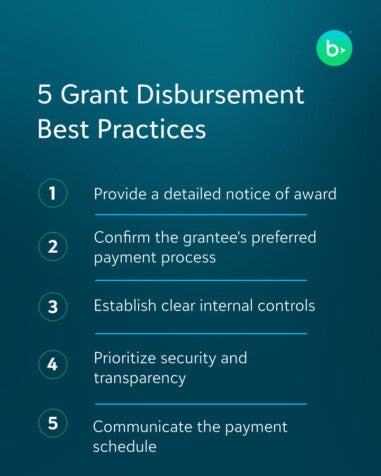Grant Distribution Best Practices: 5 Tips for Funders

Your relationship with your grantees is more than a transaction. But it’s difficult to drive impact when your grantees can’t access their funds, aren’t sure when the funds are arriving, and don’t have a clear understanding of their requirements for using the funds.
An efficient grant distribution process builds trust with your grantees and improves transparency across your organization. Here are five tips for streamlining how you get grant awards to your recipients.

1. Provide a Detailed Notice of Award
Sending out the notice of award is exciting for both the funder and the grantee. This is also where you can set up your grant distribution process for success.
Use your notice of award to clearly outline the terms of the grant, including the awarded amount, any specific requirements or expectations, and the timeline for deliverables. This transparency allows grantees to understand what you expect from them so they can plan accordingly.
Include clear—and obvious—contact information in the notice, so grantees know exactly who to reach out to with questions or concerns. This encourages open communication and funnels feedback to the correct channel instead of your front desk fielding additional inquiries.
To make the acceptance process seamless, include instructions on how to sign and return the notice. Your notice of award communication is also a great place to provide links to support resources that will help grantees successfully meet their grant obligations. These resources might include reporting templates and examples, access to community support, or information on professional development opportunities.
Finally, consider requesting acknowledgement that they received the notice of award. This confirmation can help verify that the email address is correct and there have been no changes in contact information since the application was submitted.
2. Confirm the Grantee’s Preferred Payment Process
Getting funds to your selected grantees is the whole point of your grant program, so make sure you have what you need to process the payment.
Either as part of your notice of award or as a follow-up after acceptance, ask for any additional information you need to process the payment. Consider recommending methods, like electronic transfers over paper checks, to help speed up the process. Digital payments also help reduce the risk of errors and fraud compared to paper checks.
3. Establish Clear Internal Controls for Grant Distribution
Any time you have funds moving to or from your organization, it’s important to have clear—and if possible, automated—internal controls to provide transparency and mitigate risk.
Establish tiered approvals for payments, just like you do for your expenses. Set a benchmark so any payments under that amount, such as $5,000, only need to be approved by the grants manager. Any payments over that amount need to be approved by the grants manager and a member of leadership. You keep the smaller, often more frequent, payments moving quickly while still having important controls for the bigger payments.
Because you’re dealing with grantees’ payment information, you need to have strong controls to make sure the data is stored securely. Have a place designated in your grants management system for this information and require it to be stored there—not in a spreadsheet on someone’s cloud drive or worse, in their email. Use role-based permissions to make sure only people who need access to that information within your GMS can see it.
If possible, integrate your fund accounting system directly with your GMS for real-time updates and grant progress so you can clearly see where payments are in the process and what’s been paid.
4. Prioritize Security and Transparency
When grantees and internal teams feel informed, the grant distribution process becomes smoother and more effective. Clear communication and accessible systems go a long way in fostering this trust.
Start by making it simple for grantees to track the status of fund transfers. Set up a user-friendly portal where they can log in, view transaction updates, and know exactly when funds are on their way. This eliminates uncertainty and reduces the back-and-forth email or calls.
Internally, equip your team with tools that make tracking and addressing questions seamless. A centralized system where staff can access grant-related information ensures everyone stays on the same page. This also allows team members to provide timely and accurate responses to grantee inquiries, improving overall relationships.
Consider creating reporting dashboards that clearly display key metrics. These can include disbursement timelines, budget allocation, and project progress. Dashboards not only support better decision-making but also make it easy to share updates with stakeholders.
It’s equally important to understand your legal responsibilities. Familiarize yourself with reporting requirements and ensure your processes comply with all relevant regulations. Keeping accurate, detailed records is essential—not only for compliance but also to maintain a strong audit trail. If a question or issue arises down the road, you’ll have the documentation to back up your decisions.
5. Communicate a Transparent Payment Schedule
A clear payment schedule lets your grantees know when to expect their funds. With a transparent payment schedule, they can better plan and ensure smoother implementation of their projects. From the start, provide a detailed timeline outlining payment dates, amounts, and any conditions attached to disbursement. Be upfront about your organization’s process and any delays that could arise due to administrative or compliance requirements.
Address contingencies proactively. For example, if your grant agreement includes scenarios where the award may need to be partially or fully repaid—such as unused funds or non-compliance with terms—clearly explain these conditions in your payment communication. Avoid surprises by discussing these possibilities early and including them in writing within the grant contract.
If the grant is unusually large or covers multiple years in a single disbursement, offer optional resources to help grantees manage the funds effectively. For instance, you could share budgeting templates, provide a referral to a financial advisor, or recommend attending a workshop on managing large-scale funding. This step shows your commitment to their success while encouraging accountability.
Throughout the process, stay accessible for questions. Encourage grantees to reach out if they face unexpected changes that could impact payment timing or fund use. By prioritizing clarity and providing support, you help grantees focus on their work and achieve the goals of their project or program.
Create a Better Grantee Experience with Aligned Grants and Finance Teams
Integrating your grants management system with your finance team can create a more seamless experience for grantees. By aligning these teams, you facilitate a smoother payment process, ensuring that funds are dispensed quickly and efficiently. This collaboration helps avoid delays and automates the flow, even when key personnel are unavailable.
Foster a supportive and transparent relationship with grantees through aligned grants and finance teams and pave the way for successful project execution. By ensuring efficient payment processes and clear communication, you enable grantees to focus on their goals, driving impactful outcomes for their initiatives. This synergy ultimately enhances the overall effectiveness of grant programs, benefiting both the grantees and the broader community they serve.
Looking for a grants management system that works with your fund accounting system for streamlined grant distribution? Check out our on-demand product tour featuring Blackbaud Grantmaking™ and Blackbaud Financial Edge NXT®.
